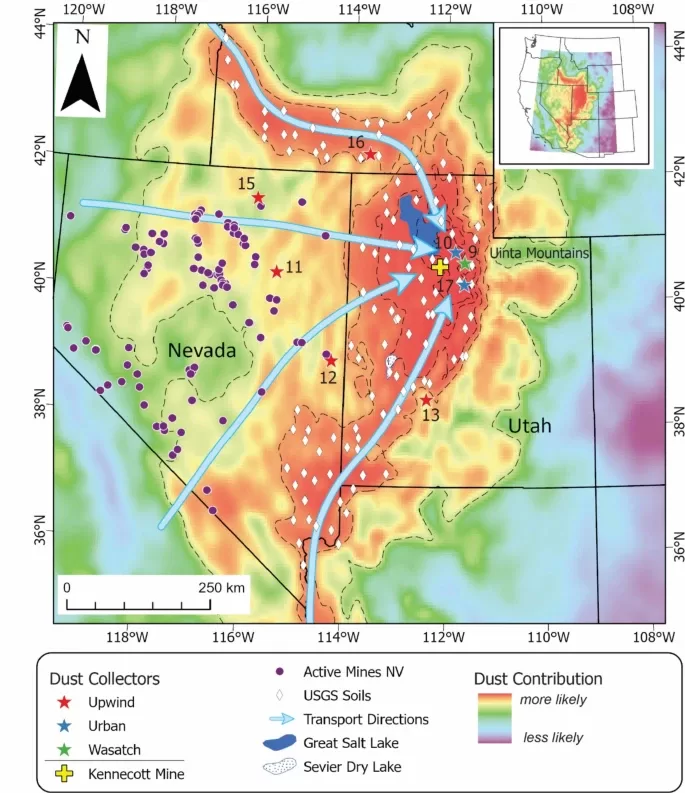"The Wasatch Mountains, though visually a fortress of steep ridges and carved canyons, do not shield themselves against lowland pollution."
Posted: December 19, 2025

In northern Utah’s Wasatch Front, heavy metals find their way into streams that feed pristine canyons, a puzzle at first glance. This mountainous corridor, overshadowed by the vast expanses of the Great Basin, hosts a thriving urban zone dotted with university campuses, biotech hubs, and busy highways. Yet a recent paper, Mixing of natural and urban dust along the Wasatch Front of northern Utah, USA, by Jeffrey S. Munroe, Gregory T. Carling, Kevin D. Perry, Diego P. Fernandez, and Derek V. Mallia, points out that what appears on the surface as simple, inevitable city air pollution is also a deeper story of dust. These fine grains—blown in from desert playas, industrial sites, and even the exposed bed of the Great Salt Lake—mix in the skies above Salt Lake City and Provo before settling into the canyons. A once-pristine environment is now speckled with traces of cadmium, copper, and zinc. The authors write, “We identified significant differences between urban and natural dust that are not attributable to the intervening landscapes,” underscoring that the dust’s composition is heavily influenced by local anthropogenic activities.
Dust may conjure images of swirling storms on remote plains or a layer collecting on bookshelves. Yet Munroe and colleagues emphasize dust’s potency for carrying more than just grit. They trace a robust trail of metals, organic residues, and other fine materials that can creep into everyday life. This story begins west of the Wasatch Range, where “relatively undeveloped, arid landscapes of the central Great Basin” offer a steady supply of natural mineral dust, as the paper notes. Historically, wind currents carried this dust into the Wasatch Front corridor, depositing it across both farm fields and mountain slopes. That is still true, yet the modern mosaic now includes urban dust sources: industrial sites, highways, and the exposed flats around the shrinking Great Salt Lake.
The authors highlight the Great Salt Lake’s receding shoreline as a prime contributor. As water levels drop from climate change and large-scale diversions, broad sections of fine sediment emerge, ready to be swept into the air. This sediment, they note, is “conditioned by over a century of urban activity,” meaning it carries an imprint of industrial runoff, urban wastewater, and the complicated chemistry of modern life. Munroe and coauthors conclude that “this urban-influenced dust is transported downwind, where it may contribute to elevated levels of cadmium, copper, and zinc in streams of downwind mountain watersheds.” Each time the wind stirs, this sediment blends with natural dust, producing a distinctive chemical fingerprint that the researchers can track from desert basins to higher elevations.
The project’s methods are as straightforward as they are telling. The team used passive collectors—essentially small trays filled with black glass beads—to trap dust over extended periods. These collectors, deployed both upwind (in relatively wild settings) and downwind (in the urban corridor), allowed the team to examine dust flux, color, grain size, and trace metals through Inductively Coupled Plasma Mass Spectrometry. The contrast proved stark. Natural dust from the Great Basin tended to be lighter in color and finer in grain size. Urban dust, in contrast, was coarser and held more metals associated with heavy industry and vehicle emissions, such as copper, lead, and zinc. The paper notes that “urban dust is notably coarser than natural dust,” and the average flux of urban dust samples “is higher than at upwind locations.”
One key takeaway is that the Wasatch Mountains, though visually a fortress of steep ridges and carved canyons, do not shield themselves against lowland pollution. Dust does not respect topography or political boundaries. In fact, some mountainous watersheds along the Wasatch Front have been labeled “impaired” under the United States Clean Water Act for metals like copper and zinc. Munroe and coauthors concede that mining could be one culprit, but they also stress that “deposition of urban-influenced dust could have consequential environmental impacts,” especially given evidence that dust can find its way into soils, meltwater, and waterways. The authors illustrate how tiny particles settling on snow can speed up spring melt, while others leach metals into streams or eventually find their way into drinking water reservoirs.
This fusion of industrial and desert dust emerges from a confluence of pressures: a changing climate, historical water management, and rapid urban growth. Agriculture, road construction, sprawl, and industrial waste each leave footprints in the form of metal-rich silt that storms can easily lift into the atmosphere. As the paper puts it, “Humans are closely connected to the dust cycle,” influencing both how dust is generated and how it may harm health. Even if a given dust particle originates in a remote desert, it can pick up extra elements from tailings piles, vehicle emissions, or industrial sediment as it traverses the Wasatch Front. By the time it settles in mountain forests, it is no longer purely “natural.” This highlights the surprising complexity of dust as a carrier, shaped by forces both ancient and modern.
The findings underscore the importance of integrated management strategies. For example, controlling dust from the exposed lakebed might involve revegetating certain areas, or managing water flow to reduce further shrinkage of the lake. Mitigating emissions from heavy traffic corridors could reduce the elevated levels of metals in dust. The authors point to “the need for integrated management strategies to mitigate dust-related environmental consequences,” suggesting that neither desert reclamation nor urban air quality measures alone is sufficient. Solutions must encompass land conservation, industrial regulation, water management, and public health planning.
The implications extend well beyond northern Utah. Dust cycles in many semiarid regions are set to intensify with rising temperatures, shifting precipitation patterns, and continued human development. The observations from the Wasatch Front parallel concerns in other areas where expanding farmland or drying lakebeds contribute to dust storms that deposit pollutants in unexpected places. The research team draws parallels to Europe, India, Bolivia, and New Zealand, where mountain ecosystems also show signs of anthropogenic dust infiltration. Urban centers in those regions, like Salt Lake City, sit adjacent to deserts or high plateaus that similarly generate large amounts of airborne material. This is a global phenomenon, with the Wasatch Front as a particularly stark example because of the Great Salt Lake’s exposed surfaces near a dense urban corridor.
In the end, the central lesson is that dust is not merely a remote hazard or a vague nuisance. It is intimately entwined with municipal life, ecological health, and economic stability. Dust can fertilize distant soils or degrade them, deliver metals into waterways, or diminish the clarity of the air we breathe. Munroe and coauthors write, “Although our work exploited the natural laboratory provided by the configuration of dust sources and urban areas in northern Utah, our results are relevant to other settings around the world.” This statement places local findings within a broader context: as climate drives further drying of lakes and soils, more communities may contend with urban–desert dust interactions.
Sustaining the well-being of people and landscapes along the Wasatch Front may hinge on understanding these dust pathways. The metal traces found in pristine canyons remind policymakers that the city is inseparable from its geological and atmospheric surroundings. The forces that desiccate the Great Salt Lake or erode farmland in the Great Basin do not simply remain “out there.” They drift on the wind, cross highways and suburban rooftops, and rise up canyon walls before finally resting in streams that supply drinking water to thousands. Whether in Utah or any other dry region, dust draws an invisible line between human activity and the health of ecosystems. By tracing that line more clearly, researchers offer a clearer perspective on how to safeguard both the arid lowlands and the mountain enclaves downwind.

 Dust^2
Dust^2